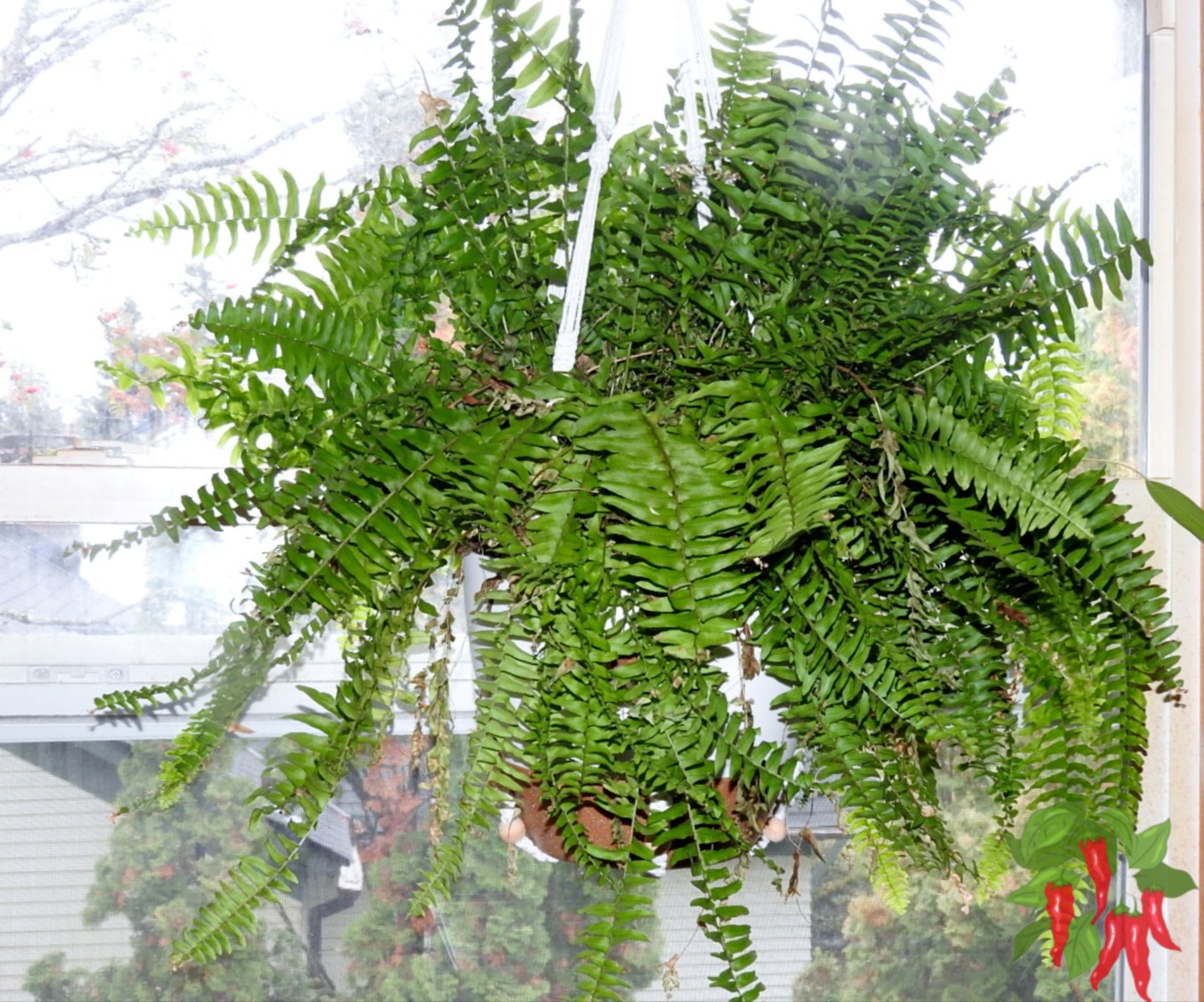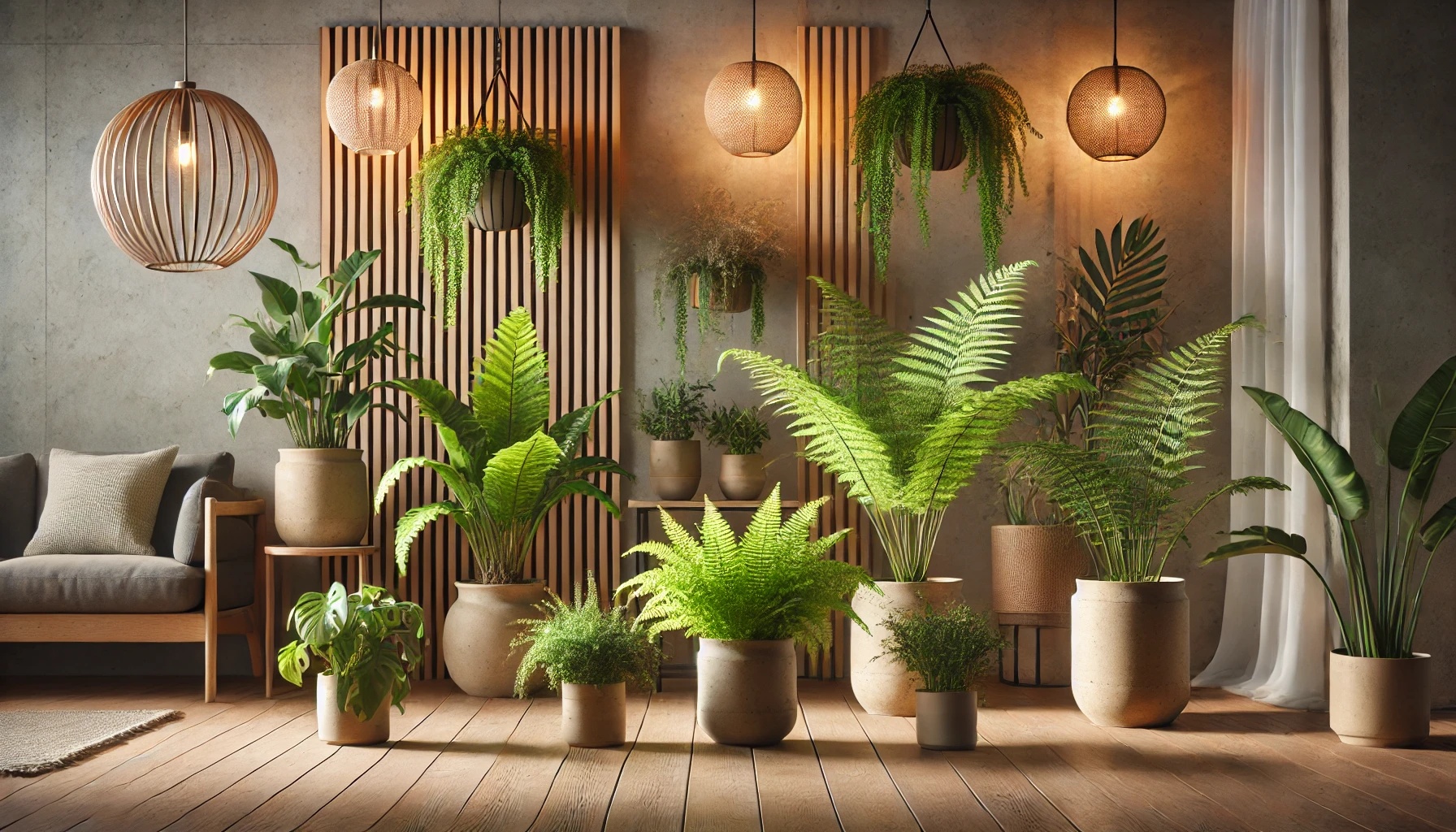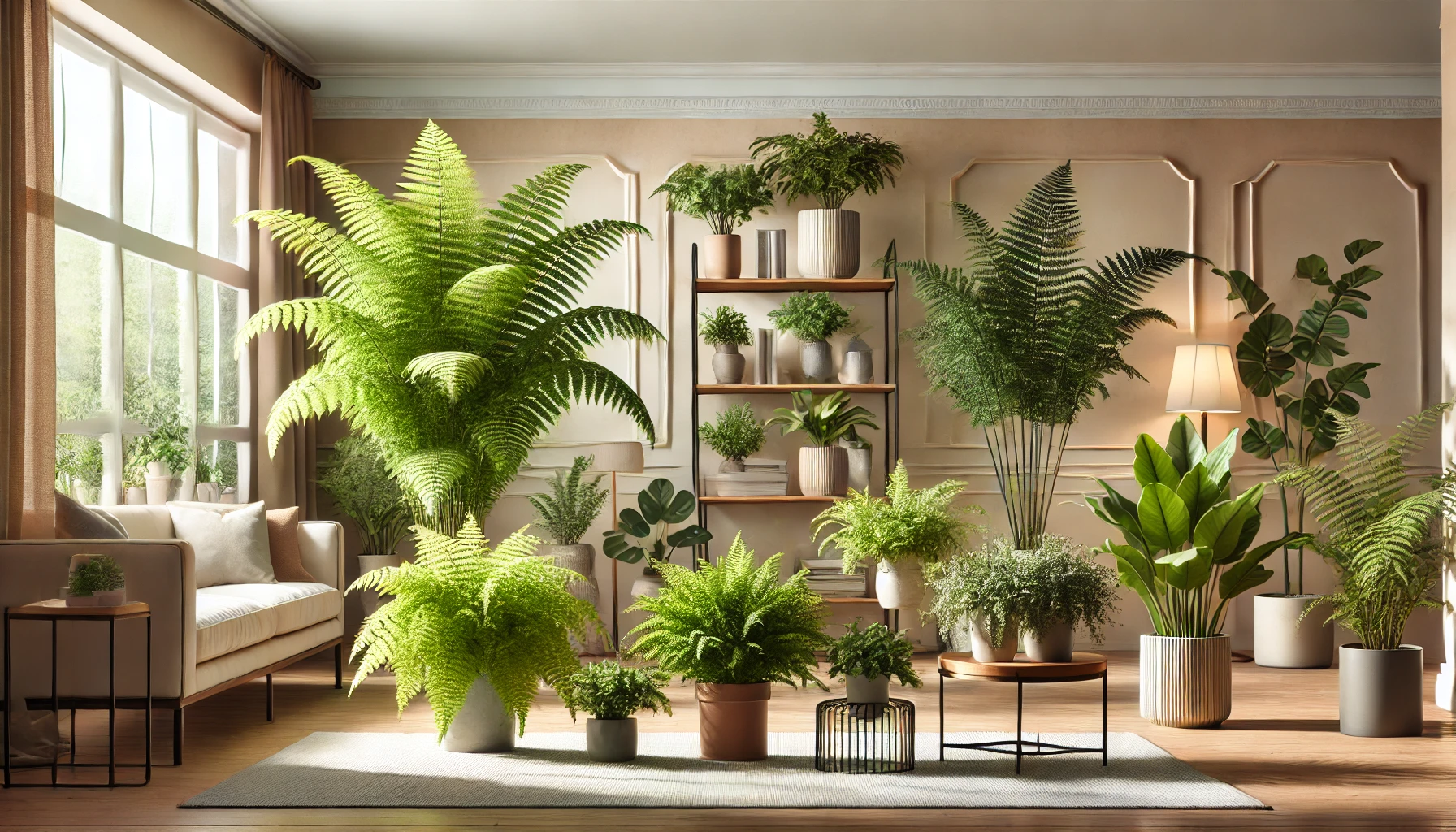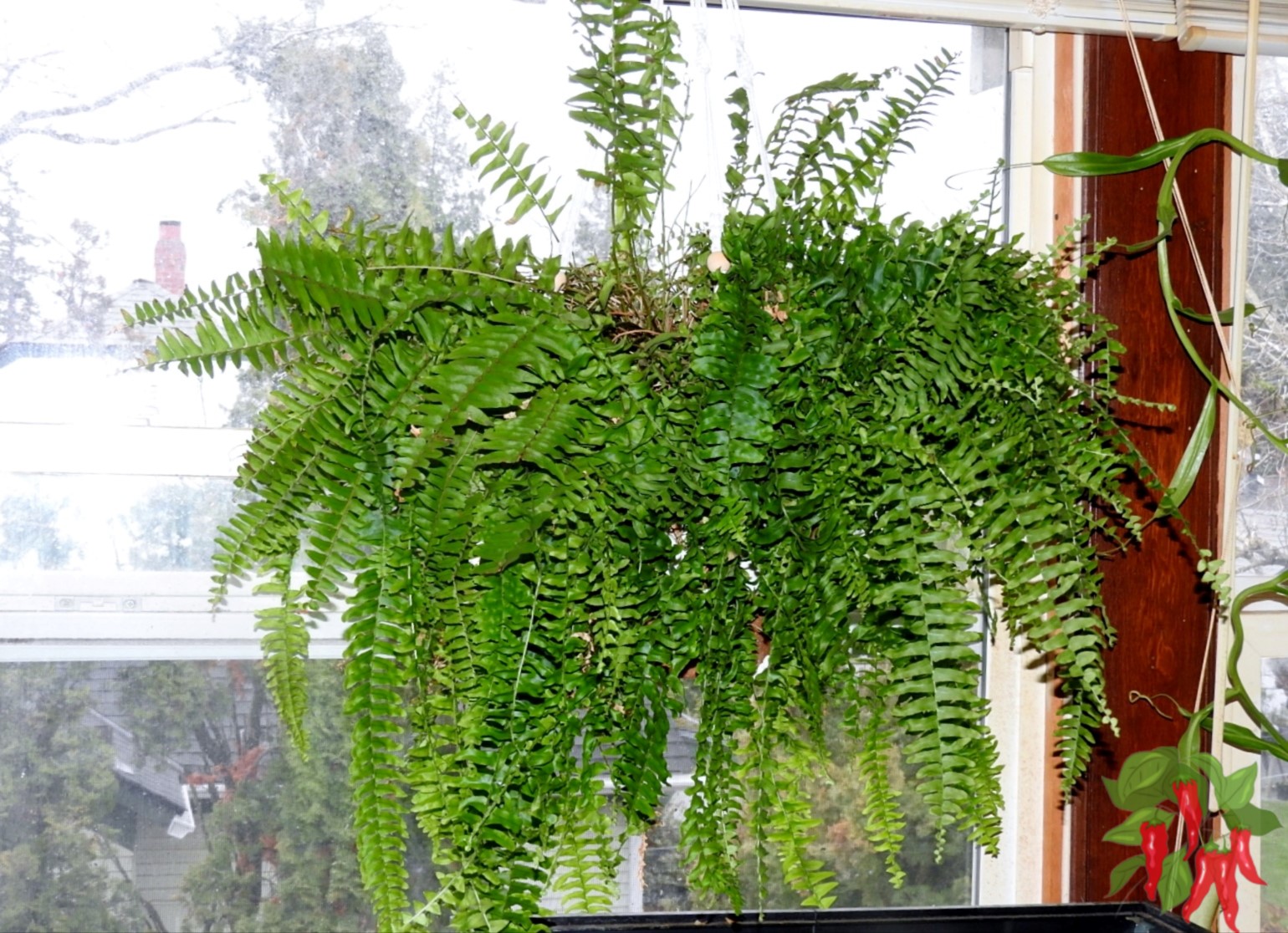This post contains affiliate links. If you buy something from one of our links we may earn a commission. Thanks
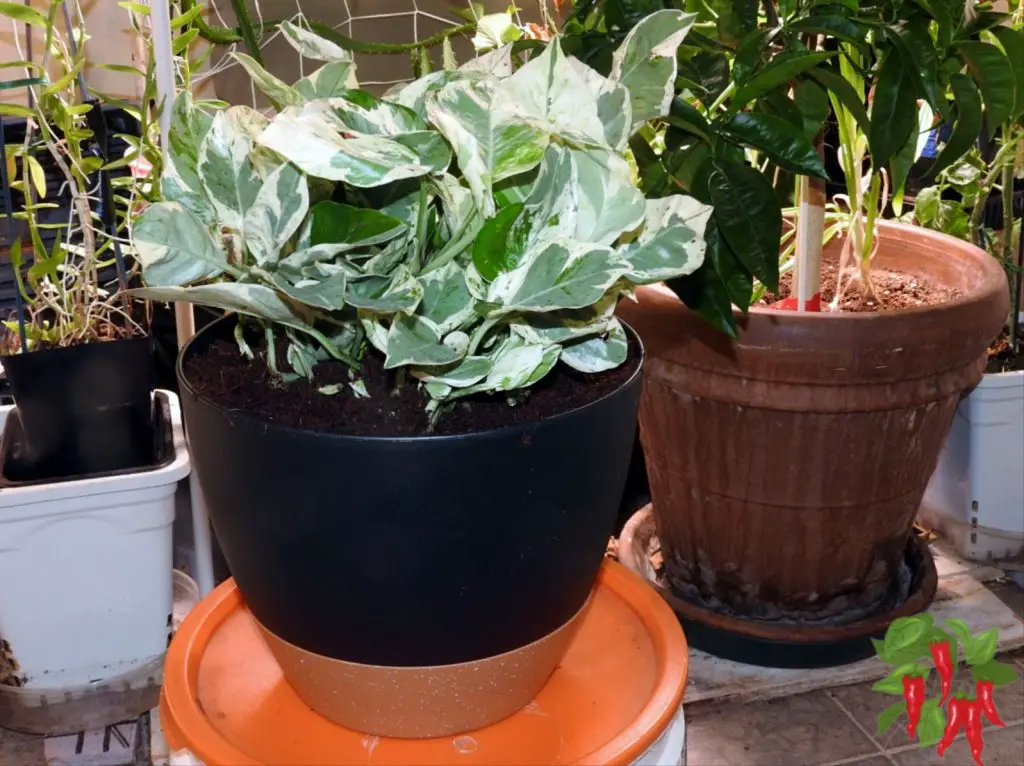
Learn how to grow Pothos indoors with easy care tips for thriving plants. Perfect for beginners, this guide covers light, water, and Feng Shui placement.
Why Grow Pothos Indoors?
Growing lush, healthy Pothos indoors can feel like a mystery if you’ve struggled with finicky houseplants in the past.
Luckily, Pothos plants are forgiving, adaptable, and incredibly rewarding.
With simple care tips, you can transform your space into a vibrant haven filled with greenery and positive energy.
How to Grow Pothos Indoors Key Takeaways:
- Here’s how to grow Pothos indoors:
- Provide bright indirect light.
- Allow the soil to dry between waterings.
- Use well-draining soil or a coco coir and perlite mix.
- Pothos thrives in minimal care settings and improves air quality.
- Place them in East or Southeast corners for Feng Shui benefits.
- They bring positive energy and prosperity into your space there.
1. How to Grow Pothos Indoors
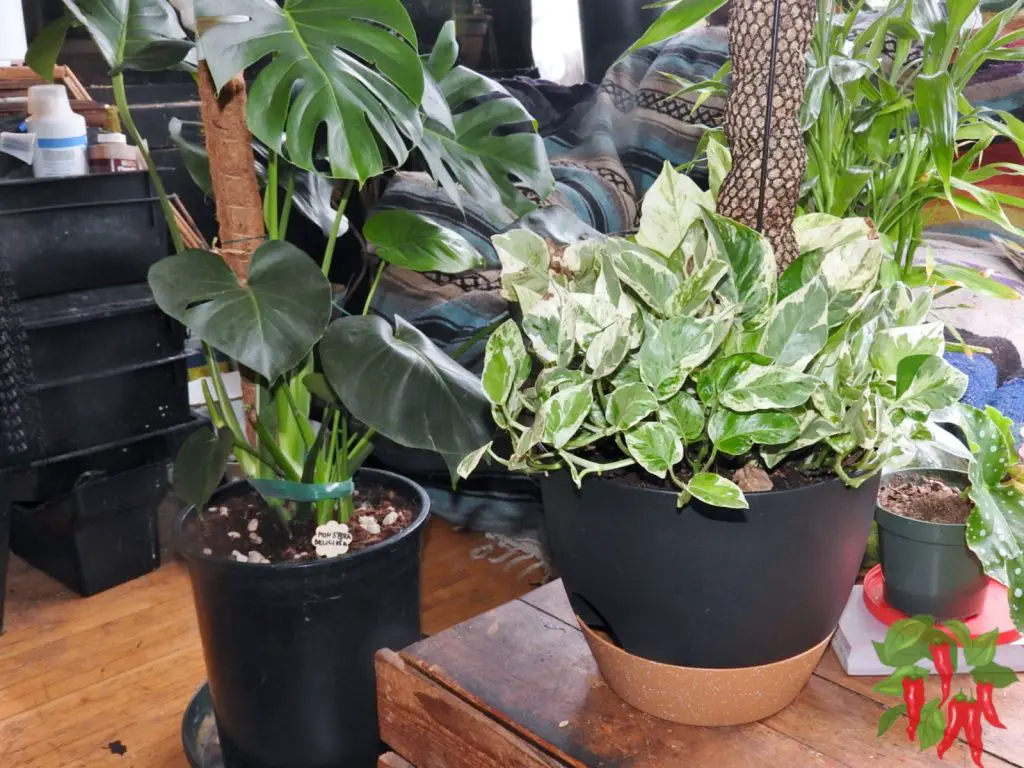
Pothos plants are a favorite for a reason. They’re incredibly easy to care for and thrive in almost any indoor environment.
Whether you’re just starting your plant journey or looking for a low-maintenance addition to your home, Pothos is a perfect choice.
Let’s cover the essentials to keep your Pothos happy and healthy.
Light Requirements
Pothos are pretty forgiving when it comes to light, making them ideal for any corner of your home.
- Ideal Light: Bright, indirect light helps Pothos grow quickly and maintain vibrant leaves.
- Low-Light Tolerance: They’ll survive in low-light conditions, but expect slower growth and possible fading of variegation.
- Avoid Direct Sunlight: Too much direct sunlight can scorch the leaves, so keep them in filtered light or a well-lit room.
Watering Needs
If you’re prone to overwatering, Pothos might just teach you to hold back.
- When to Water: Let the top inch of soil dry out before watering again. A quick finger test is all you need.
- Watch for Signs: Drooping leaves usually mean it’s time for a drink, but yellowing leaves often signal overwatering.
- Winter Adjustments: During cooler months, reduce watering since Pothos grows more slowly.
Soil and Potting
Healthy roots are the foundation of a thriving Pothos.
- Best Soil: Choose a well-draining potting mix, such as one designed for houseplants. Coco coir and perlite is an excellent sustainable alternative.
- Pot Choice: Always use a pot with drainage holes to prevent water from pooling at the bottom.
- Repotting Tips: Pothos doesn’t mind being slightly root-bound, so repot only when roots outgrow the pot or poke through drainage holes.
By giving your Pothos the right balance of light, water, and soil, you’ll have a lush, thriving plant that’s beautiful and easy to manage.
Pothos Plant Care Reference Guide
| Characteristic | Details |
|---|---|
| Common Name | Pothos |
| Botanical Name | Epipremnum aureum |
| Native Habitat | Tropical forests of Southeast Asia and the Solomon Islands |
| Plant Type | Evergreen trailing vine |
| Growth Pattern | Trailing or climbing with aerial roots |
| Mature Size | 6-10 feet indoors, longer if climbing |
| Watering | Allow the top inch of soil to dry out between waterings |
| Light/Sun Exposure | Bright, indirect light; tolerates low light |
| Soil Type | Well-draining potting mix |
| Soil pH | 6.1 to 6.8 (slightly acidic) |
| Temperature | 65-85°F (18-29°C) |
| Humidity | Prefers moderate to high humidity |
| Bloom Time & Flower Color | Rarely blooms indoors; flowers are white and spathe-like |
| Potential Problems | Yellowing leaves (overwatering), brown tips (low humidity) |
| Repotting | Repot every 1-2 years or when roots outgrow the pot |
| Hardiness Zones (USDA) | 10-12 (outdoors), suitable for indoor growing in all zones |
2. Feng Shui Placement for Pothos
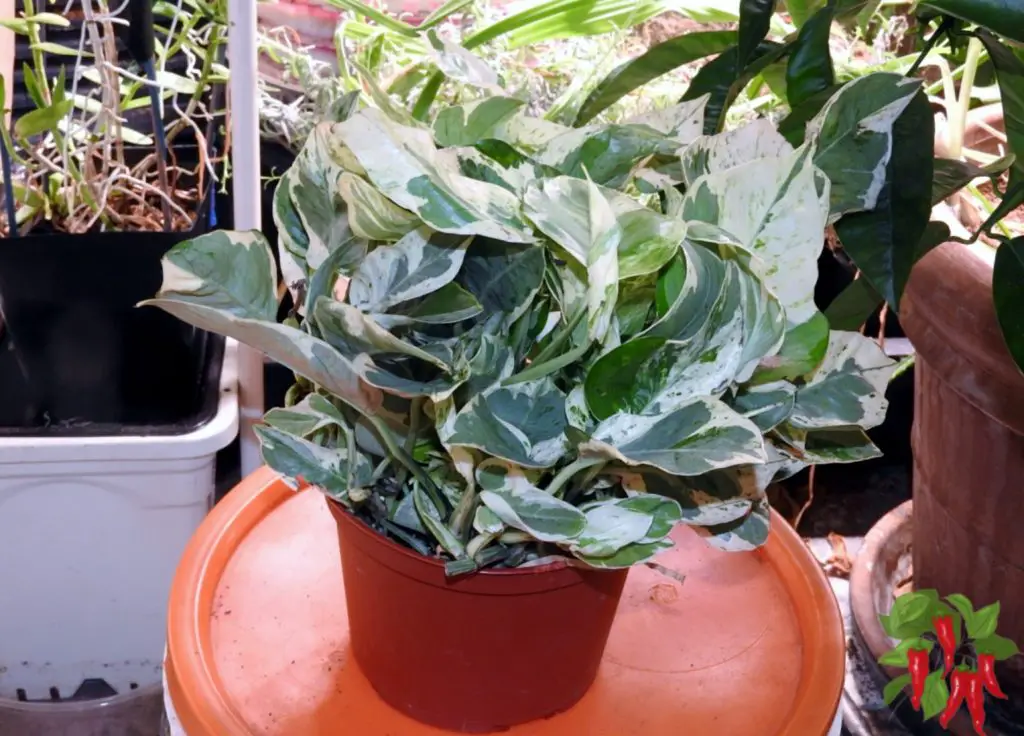
Where you place your Pothos plant can make a world of difference in the energy it brings to your space.
According to Feng Shui, these plants are not just decorative. They’re tools for enhancing harmony, health, and prosperity.
Let’s explore how to position your Pothos for maximum positive vibes.
Optimal Locations
In Feng Shui, every direction has a purpose, and Pothos can amplify energy in specific areas:
- East Areas: Symbolize health and family. Placing a Pothos here promotes harmony and well-being in your household.
- Southeast Corners: Associated with wealth and prosperity, these spots benefit greatly from the vibrant growth of a Pothos plant.
Areas to Avoid
Even a forgiving plant like Pothos needs the right environment to thrive and spread good energy:
- Cluttered Spaces: Pothos thrives where energy can flow freely. Avoid placing them in messy areas where their benefits could be blocked.
- Bathrooms: Bathrooms can drain positive energy in Feng Shui, so keep your Pothos elsewhere for a greater impact.
With thoughtful placement, your Pothos can act as a natural air purifier and a magnet for good fortune and positive energy.
3. Pothos Watering and Fertilizing Tips
Pothos plants are known for their low-maintenance nature, but getting their watering and feeding routine right can make all the difference in their health and growth.
Here’s how to keep your Pothos thriving with the perfect balance of hydration and nutrients.
Watering Schedule
Pothos plants are forgiving, but their watering routine still needs some attention:
- When to Water: Check the top inch of soil—if it feels dry, it’s time to water.
- Seasonal Adjustments: During winter, reduce watering since the plant’s growth slows.
- Avoid Overwatering: Too much water can lead to root rot. Ensure the pot has drainage holes to allow excess water to escape.
Fertilizing
A little plant food goes a long way in boosting Pothos growth:
- Frequency: Feed with a balanced liquid houseplant fertilizer every 4-6 weeks during the growing season (spring and summer).
- Avoid Overdoing It: Over-fertilizing can cause salt buildup in the soil, leading to brown tips or leaf damage.
- Skip in Dormancy: During the fall and winter months, Pothos don’t need fertilizer as their growth naturally slows.
With the right watering and feeding routine, your Pothos will reward you with lush, vibrant foliage that’s a joy to behold.
4. Pothos Varieties for Feng Shui
Choosing the right variety of Pothos isn’t just about aesthetics. It’s about aligning your plant with the energy you want to invite into your home.
Each type carries its own symbolic meaning, making it a thoughtful addition to your Feng Shui practices.
Golden Pothos 
The Golden Pothos is a striking variety that features vibrant yellow and green leaves, often associated with wealth and prosperity.
- Symbolism: Encourages financial abundance and success.
- Best Placement: Southeast areas to amplify prosperity and positive energy.
Jade Pothos
The lush, solid green leaves of Jade Pothos represent growth and harmony.
- Symbolism: Promotes personal and family growth while fostering unity.
- Best Placement: East areas to support health and family well-being.
Marble Queen Pothos
With its elegant white and green variegated leaves, Marble Queen is a stunning addition to any home.
- Symbolism: Reflects balance, purity, and clarity.
- Best Placement: Living rooms or meditation spaces to enhance serenity and peace.
N’Joy Pothos
The N’Joy Pothos variety features cream and green variegation with a clean, crisp look, which is ideal for modern interiors. Very similar to Pearls and Jade but a bit more compact.
- Symbolism: Represents joy, creativity, and uplifting energy.
- Best Placement: Workspaces or creative corners to inspire productivity and positivity.
Pearls and Jade Pothos
A delicate variety with white and green marbled leaves, Pearls and Jade add elegance to any space.
- Symbolism: Encourages wisdom and clarity, promoting a calm environment.
- Best Placement: Bedrooms or quiet reading areas to enhance tranquility.
Selecting the right Pothos variety adds beauty to your space but also brings meaningful energy to the areas where it matters most.
5. Troubleshooting Pothos Care Issues
Even though Pothos are incredibly resilient, they’re not entirely immune to care hiccups.
With a little attention to detail, you can quickly address any problems and get your plant back to thriving.
Let’s tackle some of the most common Pothos issues and their solutions.
Yellowing Leaves
Yellowing leaves are one of the most frequent concerns for Pothos owners.
- Cause: Overwatering or poor soil drainage.
- Solution: Allow the soil to dry out between waterings and ensure your pot has proper drainage holes. Check for water pooling at the bottom of the pot.
Brown Leaf Tips
Those crispy brown edges can be a sign your plant isn’t entirely happy with its environment.
- Cause: Low humidity or too much direct sunlight.
- Solution: Move your Pothos away from direct sunlight and increase humidity by misting the plant or placing it near a humidity tray.
Leggy Growth
If your Pothos looks more like a few sparse vines than a lush jungle, it’s trying to tell you something.
- Cause: Insufficient light.
- Solution: Relocate the plant to a spot with bright, indirect light to encourage fuller, bushier growth.
By keeping an eye on these common problems, you’ll help your Pothos recover quickly and prevent future issues.
6. Propagating Pothos Plants
Propagating Pothos is one of the easiest ways to grow your collection or share these beautiful plants with friends.
Whether you’re a seasoned plant parent or a beginner, you’ll love how simple and rewarding it is to create new Pothos plants.
Stem Cuttings
This is the most popular method for propagating Pothos and is practically foolproof.
- How to Do It: Cut a 6-inch stem just below a leaf node, where new roots are most likely to form.
- Water or Soil: Place the cutting in water or directly in well-draining soil.
- Patience Required: Roots typically start to develop within a few weeks. If in water, change it weekly to keep it fresh.
Division
For larger Pothos plants, dividing them is an excellent way to create multiple new plants.
- How to Do It: Gently separate the plant into smaller sections, ensuring each section has leaves and roots attached.
- Replanting: Place each section into its own pot with fresh, well-draining soil.
- Care Tips: Keep the new plants in a warm, humid spot to help them settle in quickly.
With these simple methods, you can grow as many Pothos plants as you like, turning one thriving plant into a whole collection.
7. Hanging Pothos for Better Energy Flow
Hanging Pothos plants isn’t just a stylish way to display their beautiful vines—it’s also a powerful Feng Shui tool.
By placing Pothos in key areas, you can improve energy circulation and bring vitality to stagnant spaces in your home.
Placement
Strategic placement of hanging Pothos can revitalize areas that feel heavy or lifeless.
- Above Cabinets: These often-overlooked spots can collect stagnant energy. A hanging Pothos introduces movement and fresh energy.
- Empty Corners: Filling unused corners with cascading Pothos vines helps circulate chi (energy) throughout the room.
- Near Entrances: Hanging Pothos near doorways can create a welcoming flow of positive energy.
Benefits
The trailing nature of Pothos vines naturally enhances the balance and flow of energy in a room.
- Encourages Movement: The graceful vines soften sharp angles and encourage energy to move freely.
- Balances Energy: Pothos can harmonize the energy in a space, making it feel more vibrant and inviting.
- Adds Beauty: Their lush greenery elevates any room, creating a calming yet energizing atmosphere.
Hanging Pothos plants elevate your home’s aesthetic and promote a balanced and lively energy flow.
8. Pothos and Air Quality
Pothos aren’t just pretty. They’re hardworking plants that help create a healthier indoor environment.
Known for their natural air-purifying properties, these green wonders contribute to physical and emotional well-being.
Air Purification
Pothos plants are among the top choices for improving air quality at home.
- Toxin Removal: They filter out common indoor toxins like formaldehyde, benzene, and carbon monoxide.
- Better Breathing: By removing airborne pollutants, Pothos helps create cleaner, fresher air in your space.
Health Benefits
Cleaner air doesn’t just feel better and it’s good for your health too.
- Improved Well-Being: Cleaner air can reduce headaches, fatigue, and other symptoms caused by poor air quality.
- Allergy Relief: Fewer airborne irritants mean less strain on allergy sufferers.
- Calming Presence: Their lush, green foliage adds a soothing vibe, promoting relaxation and reducing stress.
Adding Pothos to your home isn’t just a design choice. It’s a step toward a healthier, more balanced lifestyle.
9. Pothos Growth and Light Requirements
Getting the lighting right for your Pothos can make all the difference in their growth and appearance.
These adaptable plants thrive in a variety of indoor conditions, but understanding their preferences ensures they look their best.
Light Preferences
Pothos are incredibly versatile when it comes to light:
- Ideal Lighting: Bright, indirect light is perfect for keeping their leaves vibrant and healthy.
- Low-Light Tolerance: They can adapt to low-light areas, making them ideal for offices or darker corners. However, reduced light can cause variegated varieties to lose their distinct patterns and turn solid green.
Avoid Direct Sunlight
While they love light, too much can do more harm than good.
- Leaf Scorching: Direct sunlight can burn their delicate leaves, causing unsightly brown spots.
- Filtered Light: If placing near a window, use sheer curtains or move them slightly away to provide soft, filtered light.
By understanding their light needs, you can ensure your Pothos grows lush and full, adding beauty and positive energy to your space.
10. Feng Shui Symbolism of Pothos
In Feng Shui, Pothos aren’t just admired for their beauty. They also carry deep symbolic meanings that make them a treasured addition to any home.
Their lush growth and vibrant energy contribute to prosperity and harmony.
Growth and Prosperity
Pothos are often associated with abundance and success thanks to their vigorous growth.
- Symbolism: Their ability to thrive in various conditions symbolizes resilience, vitality, and financial prosperity.
- Placement Tip: Position them in the southeast corner of your home or office to amplify wealth and abundance of energy.
Harmony
The gentle, cascading vines of Pothos create a soothing presence, promoting balance and tranquility.
- Symbolism: Their calming nature fosters emotional and energetic harmony, making them ideal for living rooms and shared spaces.
- Energetic Flow: By softening sharp corners and encouraging energy to flow, they help maintain a balanced and inviting environment.
By incorporating Pothos into your indoor space and following these care and placement tips, you can enjoy a thriving plant that elevates the visual and energetic qualities of your home.
Pothos Care Indoors FAQs
Got questions about growing Pothos indoors? You’re not alone! Whether you’re a seasoned plant parent or just starting out, these answers will help you give your Pothos the care and attention it deserves.
Q. How much light does a Pothos plant need?
A. Pothos thrive in bright, indirect light but can adapt to low-light spaces. Avoid direct sunlight to prevent leaf burn.
Q. How often should I water a Pothos?
A. Water your Pothos when the top inch of soil feels dry. Overwatering can lead to root rot, so err on the side of underwatering.
Q. What type of soil is best for Pothos?
A. Use a well-draining potting mix, such as one designed for houseplants or mixed with perlite for added aeration.
Q. Can Pothos grow in low-light rooms?
A. Yes! While they grow faster in brighter conditions, Pothos are tolerant of low light and make great additions to dimmer areas.
Q. How do I propagate Pothos?
A. Take a 6-inch cutting below a leaf node, place it in water or soil, and wait for roots to form. Keep it in an indirect light for best results.
How to Grow Pothos Indoors Conclusion
Growing Pothos indoors is as rewarding as it is simple. With their vibrant foliage and minimal care needs, these plants brighten any space while improving air quality and energy flow.
How to Grow Pothos Indoors: Care Tips for Pothos Plants in a Nutshell
Pothos are versatile, forgiving plants that bring greenery and positive energy to any home.
Whether you’re aiming to improve Feng Shui, boost indoor air quality, or simply add a touch of natural beauty, these quick guidelines cover everything you need to keep your Pothos thriving and vibrant.
How to Grow Pothos Indoors
Healthy Pothos starts with understanding their basic care needs.
- Light: Bright, indirect light is ideal, but they can adapt to lower light. Just keep them out of direct sunlight to prevent scorching.
- Water: Allow the top inch of soil to dry out between waterings to avoid root rot.
- Soil: Use a well-draining mix, and ensure pots have drainage holes to prevent waterlogging.
With these simple guidelines, your Pothos will reward you with lush, trailing vines.
Feng Shui Placement for Pothos
Strategic placement of Pothos can amplify positive energy in your home.
- Best Spots: Place them in the southeast for wealth or the east for family health. Hanging Pothos in empty corners or near entrances can also help circulate chi.
- Avoid: Cluttered spaces, as they hinder energy flow, or areas with harsh direct sunlight that may stress the plant.
Using Pothos in your Feng Shui setup can create harmony and vitality in your space.
Pothos Watering and Fertilizing Tips
A balanced care routine ensures your Pothos stays healthy year-round.
- Watering: Check the soil’s top layer; water when dry. Cut back during winter months.
- Fertilizing: Use a balanced houseplant fertilizer every 4-6 weeks during spring and summer. Skip feeding in winter when growth slows.
This consistent approach keeps your plant vibrant and growing strong.
Pothos Varieties for Feng Shui
Different Pothos varieties offer visual appeal and have specific symbolic meanings in Feng Shui.
- Golden Pothos: Encourages financial success and prosperity.
- Jade Pothos: Promotes personal growth and family harmony.
- Marble Queen: Adds balance and purity with its white and green leaves.
- N’Joy: Brings uplifting and joyful energy to workspaces.
- Pearls and Jade: Perfect for tranquility and wisdom in bedrooms or meditation areas.
Choose the variety that resonates with your goals to align energy and aesthetics.
Troubleshooting Pothos Care Issues
Pothos are hardy plants, but occasional issues may arise.
- Yellowing Leaves: Usually due to overwatering. Let the soil dry out.
- Brown Tips: Indicate low humidity or too much direct sunlight. Adjust placement or mist the plant.
- Leggy Growth: Happens with insufficient light. Move the plant to a brighter spot.
Quickly identifying and addressing these problems will keep your Pothos in top shape.
By applying these insights, you’ll have everything you need to grow happy, healthy Pothos that enhance your home’s beauty and energy.
Pothos Care Key Takeaways
- Provide bright, indirect light and avoid direct sun.
- Allow the soil to dry between waterings to prevent root rot.
- Use a well-draining potting mix for best results.
- Place in east or southeast corners to encourage harmony and prosperity.
- Propagate with ease to grow your collection or share with others.
Pothos plants are a favorite among indoor gardeners for their lush, trailing vines and easygoing nature.
Final Thoughts
They enhance the beauty of your home and also bring positive energy, especially when placed according to Feng Shui principles.
This guide explores how to grow Pothos indoors, focusing on their care requirements and optimal placement for good energy flow.🌿
✨ Indoor Plants and Feng Shui
Enhance harmony, balance, and positive energy in your home with these Feng Shui indoor plant guides.
- 🌱 Feng Shui Plants (Pillar Guide)
- 🏡 Indoor Plants and Feng Shui
- 🌿 Feng Shui Vertical Gardens for Office Spaces
- 🌸 Best 24 Feng Shui Indoor Plants
- 💧 Growing Feng Shui Plants
- 🌳 Common Chinese House Plants for Feng Shui
- 🪴 Feng Shui Hanging Plants
- 🛏️ Feng Shui Bedroom Plants
- 🍃 ZZ Plant Feng Shui
- 🌱 Using Feng Shui in Vertical Gardens
- 🎋 Growing Lucky Bamboo in Feng Shui
- 🏠 Indoor Plants for Feng Shui
- ☯️ Indoor Plants for Positive Energy
- 🌼 Chinese Evergreen Care
- 🌺 Growing Peonies Indoors and Outdoors
- See all articles in our Indoor Plants and Feng Shui category
Related Content
Visit my Amazon Influencer Page for videos and gardening products Grow Your Own Garden






